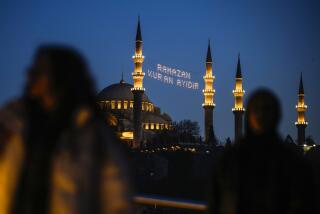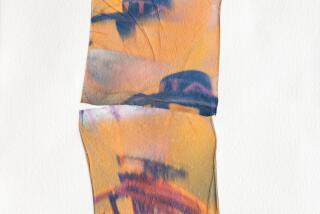An Ancient City Tries to Wall Out Modernity
- Share via
SAN'A, Yemen — Making his way through a maze of minarets, mosques and towering houses frosted with gypsum, Majam Jamal turns a corner and cringes at the sight--cement and aluminum siding.
“This is a violation,” he declares, pointing angrily at a new and decidedly modern house in the legendary old city of San’a.
“We have to safeguard our style,” says Jamal, chairman of a group set up by Yemen’s government to save the city.
Its 1,000-year-old architectural tradition has created an unforgettable, dreamlike array of towering walls decorated with swirls, zigzags and crosses of gypsum.
The closely packed houses soar as high as nine stories, sort of miniature, medieval skyscrapers that are fashioned from stone or adobe--a word that the Arabs gave to Spanish.
Stained-glass windows shimmer at night. Lush gardens still dot the old city, while goats vie for space with spice vendors along narrow, winding streets redolent of “The Arabian Nights.”
San’a itself--as tradition has it, founded by Noah’s son Shem--is one of the world’s best preserved walled cities.
For 1,500 years, it was known largely through rumors, stories and myths. Few foreigners visited San’a, and until the 1950s, there were no phones, electricity or even cars.
But in the last generation, the city has awakened to the modern world, doubling in size every four years as its people spill outside the walls, parts of which have been destroyed.
Shoddy, leaking pipes have damaged 400-year-old buildings. Traffic splashes through muddy streets, while the sheer strain of growth has weakened an infrastructure built for the 17th century.
More worrisome, experts say, is the tendency for people to resort to new styles and cheap material in building anew.
“Our enemy is cement,” says Jamal, with a wad of the mildly narcotic and widely used khat leaf stuffed in his cheek.
“Cement--in 20 to 40 years it’s gone, but this wall is 700 years old, and look at it,” he says, patting the sturdy red and black stones of a beautiful six-story building.
Jamal’s group--with the unwieldy title of the General Organization for Preservation of Historic Cities--has managed to push through laws against the use of cement, metal and some bricks.
Instead, traditional and often more expensive materials are required both for new construction and for repairs: lime, gypsum, alabaster and plasters that take days to apply.
One such concoction, called qadad, comes from crushed pumice stone mixed with lime and water and left to ferment for a week.
Understandably, not all want to make such an effort.
Jamal’s group hands out fines ranging from 500 riyals ($4) up to 40,000 riyals ($320), the latter a figure near Yemen’s per capita annual income. They give advice to Yemenis repairing and building inside the city. They also make sure that, amid reconstruction, the narrow alleys between buildings remain the width of two camels side by side.
They keep their eyes peeled for infractions.
“This is another violation,” Jamal says, gesturing at a slab of gray cement reinforcing a foundation. “But we can cover it up with gypsum--it’s not a violation after that.”
The group is undertaking bigger projects as well. It is laying black stone across the old city’s streets and, with the help of Italy, is planning a school to train traditional masons.
Despite the occasional hassle and fine, the group’s efforts are welcomed by many of the city’s 60,000 inhabitants.
“The people draw strength from the Old City,” said Mohammed Hussein, a government employee.
Even beyond the city walls, the government has made an effort to retain elements of Yemeni architecture. A lowly gas station might have a stone arch or a few stained-glass windows.
“Architectural art is valued by Yemenis. It is something unique and at the same time ancient,” said Ali el-Rijal, head of the National Center for Archives.
For Jamal, it’s something personal.
As he enters a gate, he points to an out-of-place concrete cornice atop his own home in the Old City.
“This is a violation,” Jamal says sheepishly. “It is my wife’s house, and she had it before we were married. But the inspector told me I could cover it with gypsum.”
More to Read
Sign up for Essential California
The most important California stories and recommendations in your inbox every morning.
You may occasionally receive promotional content from the Los Angeles Times.













